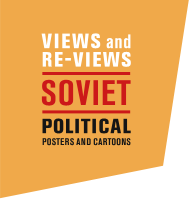
The sources for this political art were surprisingly various: nineteenth-century realism, of course, and folk art, but also the history of illustration and caricature, photomontage, and the modernism of the 1920s, always concealed, but often barely so — “hidden in plain sight,” as is sometimes said.
The dualism of friends and enemies, heroes and villains is quite apparent, stemming both from old Russian culture and from nineteenth- and twentieth-century Marxism. Enemies were both domestic — kulaks, priests, the leaders of the old regime, including the Tsar — and foreign — the nations of the Entente (Britain, France and the United States) and the epic villains of Capitalism. And of course connections were manufactured between foreign to domestic enemies, ranging from the plausible (Russian capitalism was surely part of European capitalism; Christianity is international) to the wildly implausible (Trotsky as a major figure in European Fascism). But enemies might suddenly emerge as friends under changing circumstances, as when we suddenly find the World War Two troika of Roosevelt, Churchill and Stalin against the Axis powers. The pantheon of heroes is even more obvious: Lenin and other Bolshevik leaders, the Red Army, emancipated women, poor peasants being proletarianized, Stakhanovite shock workers tripling productive norms for the sake of the community (and Comrade Stalin). But even heroes could fall. Gregory Zinoviev, represented on a poster in this exhibition, was purged by Stalin, to say nothing of Trotsky, here represented by the Kukryniksy (a Soviet caricaturist collaborative) as a Fascist lapdog.
The exhibition is drawn from an extensive private collection of Soviet propaganda and includes posters, cartoons, photomontages and postcards. The works span more than six decades, from the time of the Russian Civil War (1918-21) into the late Soviet period.
— Jo-Ann Conklin, Director, David Winton Bell Gallery
Views and Re-Views continues at John Hay Library, with auxiliary selections at the Cogut Center for the Humanities and the John D. Rockefeller, Jr. Library. The exhibition and associated programs are sponsored by the David Winton Bell Gallery, Brown University Library, Cogut Center for the Humanities, and Office of the Vice President for International Affairs.


Welcome to Views and Re-Views, a powerful sampling of more than 160 images from a private collection of twentieth-century propaganda art. In their presentation of posters and political cartoons from the Soviet period, curators Jo-Ann Conklin, Director of the Bell Gallery, and Abbott (Tom) Gleason, Keeney Professor of History Emeritus, invite us to think about these images in new ways.
The stunning images in this exhibit evoke an imagined world of enemies and heroes, set against an historical backdrop of brutality and intense human yearning. How can propaganda open a window into what was actually happening, whether in the world for which they were created or in the world about which they expressed criticism, hostility or humor? Might we imagine now how these images were then received — or rethink our own reactions to them now? How does propaganda communicate? Is it direct, popular, vernacular art, or something made and understood then and now more indirectly?
These images remind us that the music, art and literature of the mid-to-late Soviet period have often been scorned as politically coerced, their creators to be pitied, and only occasionally admired for their bold aesthetics. Views and Re-Views invites us to reconsider that tradition, perhaps in light of our own era’s rigidities of politics and taste.
Perhaps if we imagine the difficulty of untangling the flurry of media images, communication and miscommunication surrounding our national election, we may glimpse something of the tortuous labyrinth required to appreciate the real and unreal in these posters and cartoons.
Propaganda art can be as much about art as propaganda. Revisiting these images, many of them famous or iconic, may also spur us to reconsider the relationship between the art of the high Soviet Union and that of the West, and perhaps to re-assimilate the art of the twentieth-century Soviet world into the mainstream of European and Western modernism.
Wanting neither to chill the power of each image nor dampen the flourish of our own individual reactions, Conklin and Gleason’s presentation artfully and intelligently engages us in a process of historical revelation intertwined with our effort to discern some element of personal truth and understanding.
On behalf of Brown University, let me welcome you to view — and to review!
— Harriette Hemmasi, Joukowsky Family University Librarian

























